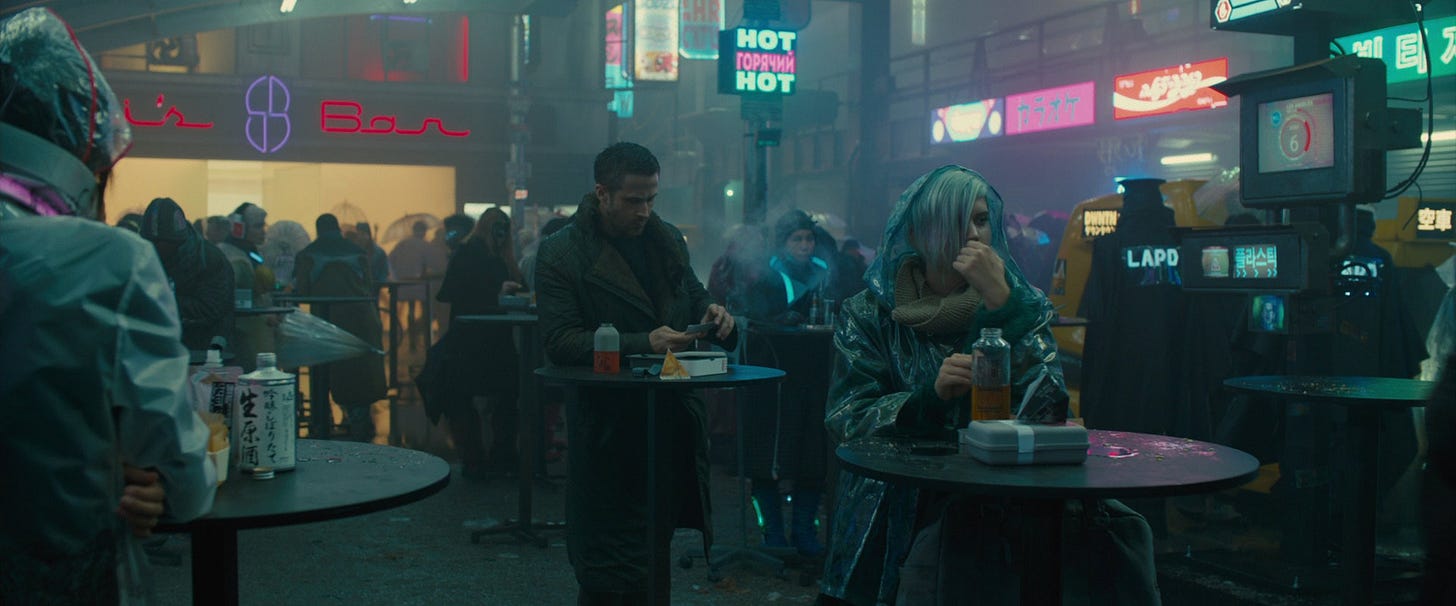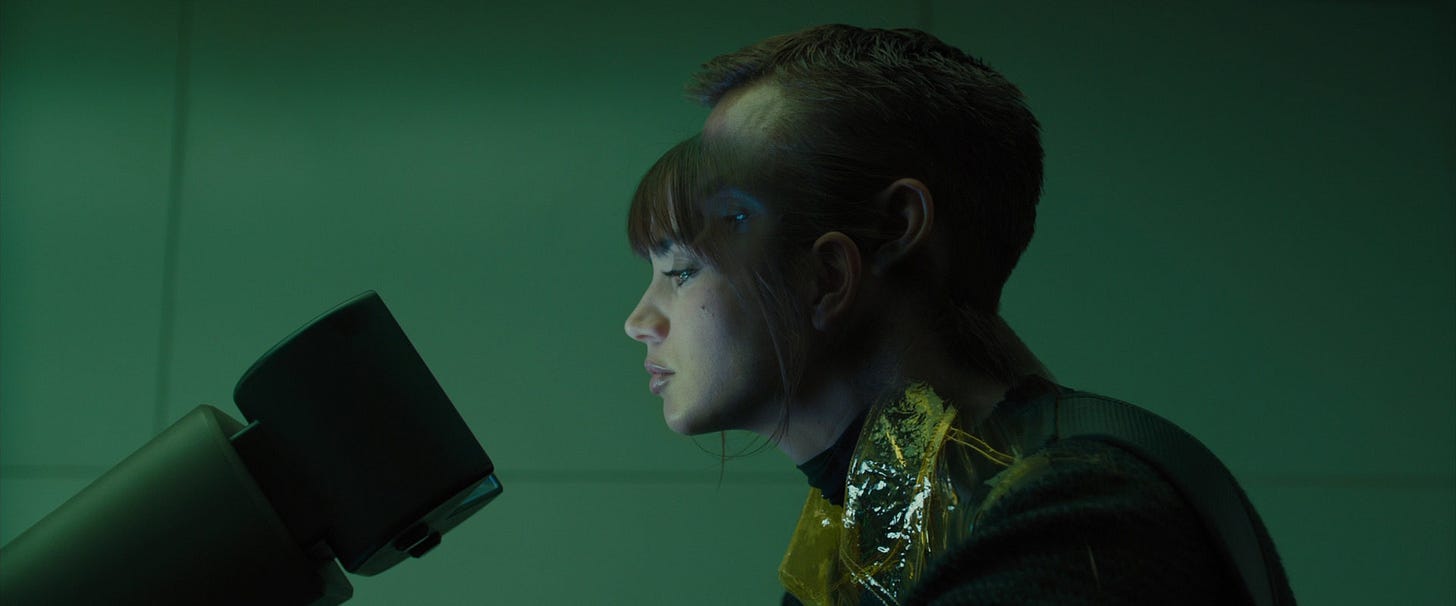Blade Runner 2049 Illuminates the Biopolitics of a Post-COVID-19 World
Denis Villeneuve’s Blade Runner 2049 depicts a world set only 26 years ahead of our own, and things aren’t faring too well. Despite its visually stunning depiction, the foreboding dread of the film’s dystopian landscape weighs on both its characters and the audience. Agent K, the film’s protagonist played by Ryan Gosling, is a synthetic humanoid known as a replicant. Working as a blade runner in an environmentally degraded Los Angeles, K is tasked with “retiring”—an eerie euphemism for killing—older replicant models deemed unfit and outdated. After evidence hinting at the possibility of replicant reproduction surfaces, he embarks on a journey to determine whether he was the first naturally born replicant.
For decades, Ridley Scott’s 1982 sci-fi classic Blade Runner, as well as the film’s literary source, Do Androids Dream of Electric Sheep? (1968) by Philip K. Dick, have stimulated discussions revolving around human-technology relationships and their potential dangers within an unregulated capitalist landscape. Blade Runner 2049 emerges not only as a sequel to Scott’s film but as a reinterpretation of the original film’s themes and vision for our time. Its depiction of increasingly relevant topics of social isolation, extreme surveillance, and unregulated technology draw striking parallels to the direction our world seems to be headed post-COVID-19. When watching, though, one must still ask why these relevant issues are amplified to the degree shown in the film’s not-too-distant future. The common deduction when examining many science fiction films within the Cyberpunk genre is that an exponential reach of large corporations has overshadowed the power of the government, propelling society into a state of inequality, crime, and corruption. Blade Runner 2049 peels back additional layers by illustrating how corporations within its universe are able to exercise the power that they do. In answering this question, 2049 focuses on latent uses of biopolitics that enable these entities to maintain a tight grip on every facet of life.
French philosopher Michel Foucault established the concept of biopolitics as an array of mechanisms utilized by modern states to administrate and regulate the health of whole populations. Foucault’s concept is grounded in empirical evidence based in 18th century Europe, focusing on the shift from the disciplining individual bodies to the biopolitical regulation of birth rate, mortality rate, longevity, and reproduction en masse. Foucault famously mentions the transition from sovereign power to “let live” and “make die” to biopolitical power to “make” live and “let” die, a shift towards the governing of life. While Foucault maintains that biopolitics is not inherently positive or negative, he warns against extreme seizures of power with biopolitical targets of control such as birth rate, mortality rate, longevity, and reproduction.
Blade Runner 2049’s representation of biopolitics serves as an explanatory lens through which we may analyze the biopolitical state of our own world and where it may be headed. Because the film is preceded by the somewhat less biopolitical Blade Runner, new mechanisms found in 2049 and their development from the original film serve to perfectly illustrate a biopolitical shift across the Blade Runner timeline. A similar biopolitical shift in our world as we enter a post-COVID landscape becomes illuminated as a result. Normalized biopolitical mechanisms that emerge in Blade Runner 2049 forecast where our current society could be headed as we transition out of the global pandemic but still see persistent biopolitical mechanisms.
From the Voight Kampff Test to the Baseline Test
In Blade Runner 2049, the baseline test is administered to known replicants daily, monitoring their emotional state and ensuring they aren’t developing “human” thoughts that may lead them to question the subjugation they are placed under. Failure of the test results in a replicant being retired. The baseline is inherently biopolitical as it calls for one to present one’s body on a regular basis for verification, then validating and framing this individual body within a larger dataset of all bodies. The testing device is mounted to a wall and given its own isolated room, emphasizing its embedded, normalized nature.
Notably, 2094’s baseline test is a biopolitical reinterpretation of the Voight Kampff test found in Blade Runner. The Voight Kampff test employs the sovereign mode of punish described by Foucault. A blade runner carries the test to individually suspected replicants. Failure of the test reveals one as a replicant, prompting the blade runner to retire them. The shift from the conditional administering of the Voight Kampff test to the regular, biopolitical administering of the baseline test parallels the emergence of routine, mandatory testing procedures during the COVID-19 pandemic.
On November 4, 2021, the U.S. Department of Labor’s Occupational Safety and Health Administration issued an emergency temporary standard (ETS) detailing a mandatory COVID policy for more that 84 million U.S. workers. Designed to help protect employees of large employers (100 or more employees) from virus exposure, the ETS required employers to implement policies requiring regular COVID-19 testing or proof of vaccination. The ETS and similar routine testing requirements have been credited with their significant role in limiting the spread of COVID-19. By targeting workers, the ETS protected an overwhelmingly large portion of people killed and infected by the virus. Regular testing and vaccination practices are not inherently negative, especially when used to curtail a deadly global pandemic. During the pandemic, however, the ETS and similar policies have normalized both the request for individuals to present their bodies and the subsequent verification and framing of these bodies within a dataset of millions of others. The routine, biopolitical nature of these processes draws connections to the regular administering of Blade Runner 2049’s baseline test, despite their vastly different motives. It’s important to acknowledge the ways in which the normalization of this biopolitical mechanism may persist after the pandemic and the unchecked power it may allow.
Joi: Companion or Imposter?
Joi is introduced as a digital companion developed by Wallace Corporation—the central antagonistic force that poses threat to K throughout the film. Quite disturbingly, she is a commodity, a brand from Wallace Corporation constrained to act out the desired roles of customers. When introduced, she’s confined to K’s apartment, projected as a hologram from a ceiling device. Yet, hardwired into Joi’s program, she longs to spend more time with K outside of his apartment. Just as one may be led to purchase the latest iPhone accessory, K purchases a portable “Emanator” device that allows for Joi to accompany him beyond his apartment. A closer reading into Joi’s nature, especially her longing to be close to her consumer, reveals that beneath the surface she serves the biopolitical purpose of the Wallace Corporation to monitor the movement of individuals and collect their data.
Nevertheless, K understands Joi’s underlying intentions. When he is forced to flee Los Angeles after failing the baseline test, Wallace Corporation attempts to track him through Joi. Knowing this, K breaks the Emanator antennae that enables Joi’s tracking ability. Not only do invasive surveillance and tracking methods pervade the world of Blade Runner 2049, but they lie in plain sight.
A similar normalization of location tracking and data gathering has emerged during the COVID-19 pandemic. Companies that track and surveil location and movement reported widely on the findings of their data during the period. In April 2020, a news story emerged of a group of spring breakers who initiated an international spread of COVID-19 stemming from a single Fort Lauderdale, Florida beach. X-mode, a location data aggregation platform, in partnership with data visualization company Tectonix, analyzed the secondary locations of mobile devices after visiting the beach. In a Twitter post, Tectonix wrote,” Want to see the potential impact of ignoring social distancing?”, while sharing a map showing the extensive spread of COVID throughout the U.S. stemming from the spring break trip. Location data tracking did not emerge during the pandemic; Silicon Valley companies had delt with countless data privacy scandals in past years. The circumstances of the pandemic, however, created a sense of justification for location data tracking that emboldened companies such as X-mode and Tectonix to share their data visualizations widely on social media.
The public touting of the data collection technology seen from X-mode and Tectonix is only possible within an atmosphere where these mechanisms are widely accepted and normalized by everyday citizens. The comfort Joi brings K allows him to overlook her underlying functions of data collection. Similarly, we accept our data collection when, as was the case with curtailing the pandemic, it aims to protect our safety. However, as we exit the COVID landscape, we must draw attention to the ways location data collection has been normalized by this recent period. Companies no longer have a reason to track our movement, but still do.
Endless Archives
Throughout Blade Runner, we follow blade runner Rick Deckard as he tracks and retires a group of rogue replicants. He relies on what’s called an Esper Machine to analyze fine details of photographs, gathering clues to guide his mission. In addition to the individualized, disciplinary Voight Kampff test, the use of devices like the Esper to retrieve data on replicants is not biopolitical. Because a robust population-level data storage system for replicants does not exist, Deckard is forced to spend nearly the entire film searching for clues about the replicants and their whereabouts.
In Blade Runner 2049, however, K’s early process of retrieving information on a specific replicant’s identity is reduced to a single scene. In it, he finds his information within a vast archive at the headquarters of the Wallace Corporation. The Corporation not only collects data through products like Joi but also engages in the storing of this data through millions of personalized genetic profiles. The profiles contain data on the health, personal activities, consumer behavior, and memories of individuals. The existence of this systematized database is not hidden within the world of 2049. Instead, it is normalized and accepted to the extent that K is able to physically visit its archives.
Data collection and personalized data storage are normalized, intertwined processes, both facilitated by the Wallace Corporation. Through surveillance devices like Joi, the corporation is able to gather and store data on individuals. Subsequently, it draws upon this vast archive of data to manipulate and control the activities of its customers through these same devices. Through this biopolitical cycle of data gathering, storage, and manipulation, Wallace Corp retains a tight grasp over the control of human bodies and minds of an entire population.
While data collection has become normalized during the pandemic by companies such as X-Mode and Tectonix, it’s important to understand that similarly to the Wallace Corporation, these same companies control large banks of personalized data. AdSquare, a partner of X-Mode, claims a data bank of 450 million user profiles from over 120 data providers. Data stored by companies like AdSquare and Tectonix is largely believed to be anonymized, as the companies claim that users are identified by codes instead of names. However, a study of mobility data conducted by researchers from the MIT Media Lab was able to identify 95% of individuals using only four recorded spatiotemporal data points. This study, along with many others, reveals that most of this data is personalized. In understanding the ways in which the pandemic normalized data tracking and surveillance, one must also understand the biopolitical act of storing this data within a dataset of millions of personalized profiles. Wallace Corporation’s use of these two biopolitical mechanisms in conjunction forecasts the ways in which they might be used by corporations in a post-COVID world.
Conclusion: An Interim Period
Not only does Blade Runner 2049 accurately depict the mechanisms of Foucault’s biopolitics, but it highlights a notable shift within the Blade Runner universe from its less biopolitical predecessor. This dynamic between the two films illuminates ways in which a similar shift is happening in our own world as we exit a global pandemic. In a premonitory way, Blade Runner is set in 2019 and can be thought of as representing a pre-COVID world in which powerful biopolitical mechanisms were not as normalized as they are now. In 2023, we find ourselves in a unique interim period. We must look back and identify the role of the pandemic in normalizing these biopolitical mechanisms. Then looking forward, we must also regulate and de-normalize these mechanisms before they reach the extreme state shown in Blade Runner 2049.
Bibliography
Alexandre de Montjoye, Yves, et al. “Unique in the Crowd: The privacy bounds of human mobility.” Sci Rep 3, 2013, https://doi.org/10.1038/srep01376. Accessed 2 November 2023.
“Cellphone Mapping Tech Shows How Fort Lauderdale Spring Breakers Could Have Spread Coronavirus.” CBS News, 5 Apr. 2020, www.cbsnews.com/miami/news/cellphone-mapping-tech-fort-lauderdale-spring-breakers-coronavirus-spread.
Foucault, Michel. Society Must Be Defended: Lectures at the Collège de France, 1975-76. 1st ed., Macmillan, 2003.
Levinson, Charles. “Phone Tracking Is Having a Moment, but Gay Dating App Scruff Wants No Part of It.” Protocol, 31 Dec. 2021, www.protocol.com/scruff-rejects-selling-location-data.
Oliver, Kendra H., et al. “The End of Genetic Privacy in the Blade Runner Canon.” J Lit Sci, vol. 14, no. 1-2, 2021, pp. 108–24, www.ncbi.nlm.nih.gov/pmc/articles/PMC9731365/. Assessed 2 November 2023.
O’Sullivan, Donie. “How The Cell Phones of Spring Breakers Who Flouted Coronavirus Warnings Were Tracked.” CNN, 4 Apr. 2020, www.cnn.com/2020/04/04/tech/location-tracking-florida-coronavirus/index.html. Accessed 2 Nov. 2023.
Sanderson, Jerika. “Blade Runner: 2049 and Biotechnology.” Critical Posthumanism Network, 23 Sept. 2020, www.criticalposthumanism.net/blade-runner-2049-and-biotechnology/#:~:text=The%20biometric%20data%20used%20to%20track%20replicants%20is,social%20identification%20is%20permanently%20incorporated%20into%20their%20bodies.
Tectonix [TectonixGEO]. “Want to see the true potential impact of ignoring social distancing? Through a partnership with @xmodesocial, we analyzed secondary locations of anonymized mobile devices that were active at a single Ft. Lauderdale beach during spring break. This is where they went across the US:” Twitter, 24 March 2020, 6:44 PM, www.twitter.com/TectonixGEO/status/1242628347034767361.
U.S. Department of Labor. “US Department of Labor Issues Emergency Temporary Standard to Protect Workers From Coronavirus.” DOL, www.dol.gov/newsroom/releases/osha/osha20211104.







